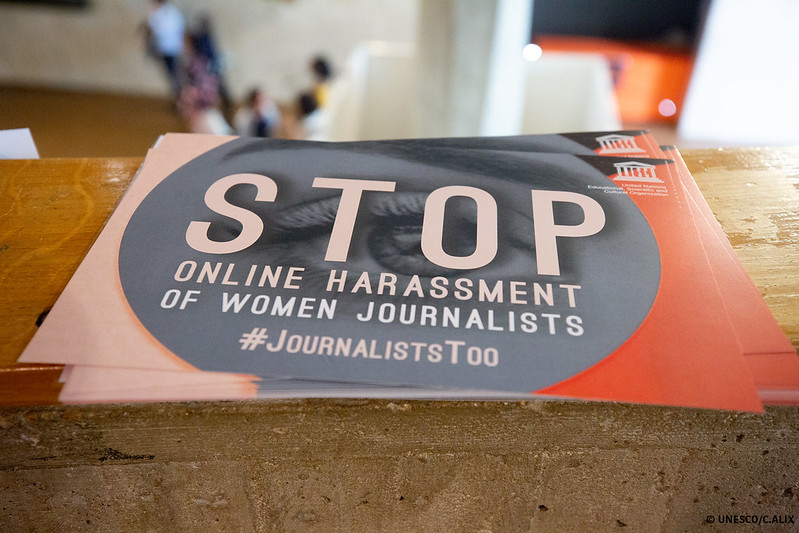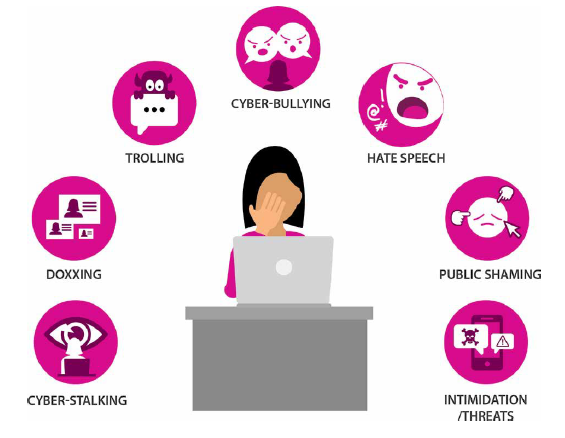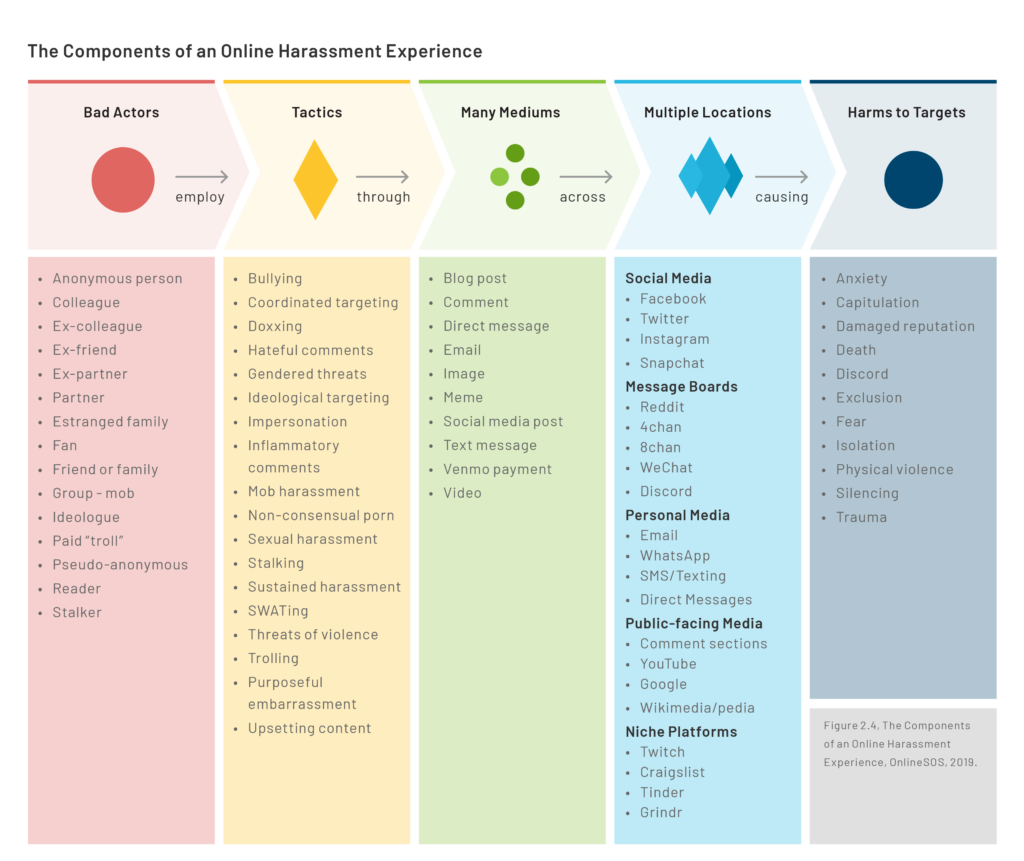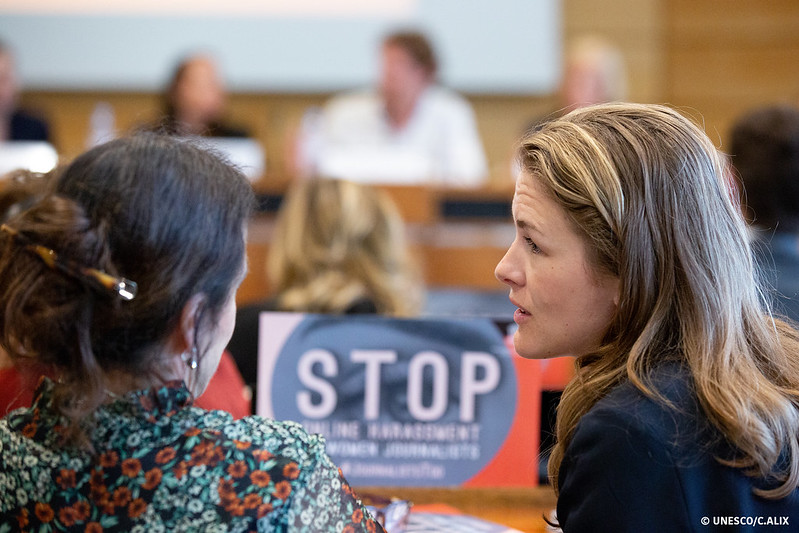
Online sexual harassment, also known as gender-based harassment, includes a range of behaviors from subtle “backhanded compliments” to comments about your appearance to overt threats of sexual and physical violence.
“Although men and women both experience harassment online, women experience a wider variety of online abuse and are disproportionately affected by more serious violations, including being stalked, sexually harassed, or physically threatened,” noted researcher Jennifer Rubin, who studies gender, sexuality and digital harassment, in a recent email interview with freelance reporter Kristi Eaton.
For Black women, women of color and LGBTQAI+ individuals, the attacks can be even more acute, including more intense and more frequent abuse. The burden of this online violence has been documented for years by Black women activists and scholars (who have also found themselves at the center of various harassment campaigns), deeply explored by nonprofit organizations like Amnesty International, TrollBusters + the International Women’s Media Foundation, Glitch (among many) and has been the subject of a wide range of academic studies.
The pandemic has driven us more online than ever, and a tense U.S. election season rife with racism and divisive discourse, has only made response more challenging.
The goal of abusers is to silence the people they target and exclude them from the public sphere. Of course, in a world where our lives are conducted almost entirely online (especially now), this is an unacceptable outcome.

So what can you do if you’re targeted with gender-based harassment or online sexual harassment?
While there’s no single, prescriptive solution or response to these situations, let’s break down a few suggestions and best practices.
1. Recognize this is not your fault.
A harasser’s goal is to silence and exclude—regardless of what you have said or done. Online harassment is not your fault and when you first react to the situation, it can be helpful to take a step back and boost your confidence during this stressful situation.
2. Get to a safe place.
Your safety is the top priority. If someone or a group threatens you, take those threats seriously. If you can, get to a safe place or at least let someone know about what’s going on. If you feel comfortable doing so, report the harassment to law enforcement.
In addition, turn off location tracking on your phone and various app settings, as well as consider locking down (or making private) your social media accounts for a bit.
3. Assess the situation.
Online harassment can trigger a “fight or flight” response in our brains. It’s a completely normal reaction to feel stress, anxiety and fear during and after an online attack. Not knowing the harasser and being unable to discern their intentions or capabilities can compound those feelings too. Facing threats, vile comments and caustic DMs is scary.
However, it can help to assess the situation and identify what’s happening, including naming the type(s) of tactics you’re experiencing and who may be behind the abuse. This exercise allows you to pause and consider what next steps are best for you.
Use the chart below to learn a bit more about the online harassment experience and to help you map what your own experience looks like.

Bad actors employ various tactics of harassment and intimidation through many mediums and across platforms to cause very real harm to targets. This graphic is from OnlineSOS’ 2019 in-depth report about online harassment in a post-2016 U.S. election world. Journalists are familiar with “Who, What, Where, When and Why”—this chart tries to cover similar questions.
At this stage, you can also complete a threat assessment, similar to a Q&A, to help you determine what’s important to you, identify specific risks and weigh next steps. It can be helpful to do this with a trusted friend or colleague.
4. Document, document, document.
Documentation is one of the most important steps in responding to any kind of online harassment. Documentation is tedious but critical to preserve evidence of the attack(s) in case you need to report to law enforcement or platforms.
If you face repeated attacks, log the entire series of events with notes. Take screenshots, save direct links, and download videos or other media evidence.
If you’re feeling overwhelmed, ask a friend to help you monitor and document the harassment.
At the very least, you’ll want to note:
- Date (and time, if possible)
- What happened
- Evidence that it happened
- Who you think did it
- Evidence you have of (4)
- Evidence you might still need to collect
- User handle, URL, and any context about the incident or why you’re concerned
You can find a more detailed guide and template for how to properly document online harassment, here.
5. Seek solace and support among your peers, friends or family.
Having gender-based or sexually explicit harassment thrown at you is stressful and upsetting. Surround yourself with a small trusted group of colleagues, friends or family with whom you can confide and seek support.
In our work at OnlineSOS, we’ve noted that journalists who speak to a group of peers about what they’re going through offers a much-needed boost of confidence and assurance when going through these types of experiences.

6. Report the harassment to the relevant platforms.
Use your documentation to help you demonstrate the harm caused. Note that it’s important to document the harassment before reporting it. Otherwise, you may lose evidence if the offending content is removed. If this process is triggering or retraumatizing, consider having a trusted friend or peer reach out to the sites.
“Someone who is a target of online gender harassment should report the incident to the platform. … Look for accessible online forms for reporting harassment; visible links that connect users with content moderation specialists; or community guidelines about available anti-harassment tools. Since some users may be doxxed through online harassment, it is important that targets protect their personal identities (e.g., address, full name). [Targeted individuals] may want to inform their employers, family, and close friends if their personal information is released online to mitigate potential consequences of this abuse.”
— Researcher Jennifer Rubin
7. Step away if you need a break.
Receiving sexualized and gendered harassment can be overwhelming, upsetting and interrupt your personal and professional life. It’s completely okay to step away and take care of your emotional well-being.
While you step away, a friend or colleague can keep an eye out for new or escalated threats and let you know if there’s a concern for you to report. They can monitor your social media accounts, email and other relevant platforms. It may also help for your friend or colleague to set up a Google alert with your name as a keyword.
Finally, remember that you’re not in this alone. No one should suffer in silence and no one should be silenced because of online harassment. Your voice is needed out here.
OnlineSOS is a nonprofit that develops guides, how-tos and content to support journalists facing online harassment. Visit our website for more resources and information about online harassment. This article is a summarized version of our Action Plan for responding to online sexual harassment or gender-based harassment. To review all the steps, tips and additional resources, click here. Special thanks to freelance reporter Kristi Eaton and digital security expert Runa Sandvik for their work on the Online Sexual Harassment Action Plan.
You may also like:





